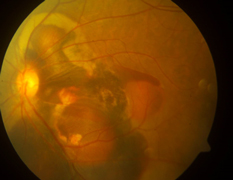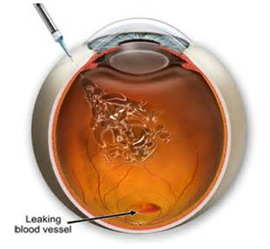Age-related Macular Degeneration (AMD)
Age-related macular degeneration (AMD) is a condition that causes central vision loss in individuals over the age of 50 years. It is one of the top 3 causes of blindness around the world. By 2020, it is estimated that there will be about 196 million individuals with age-related macular degeneration!
AMD affects the central fixation point of the eye (macula) and loss of central vision can be severe and permanent. This condition also has a tendency to affect both eyes. However, peripheral vision is usually unaffected.
Symptoms of AMD (Age-Related Macular Degeneration)
Many people with age-related macular degeneration don’t have symptoms until the disease progresses. You may experience:
- Blurring of central vision
- Distorted vision, where straight lines appear wavy or bent
- Difficulties seeing when moving from light to dark settings
- Dark patches in the centre of your vision
- Decreased intensity or brightness of colours
- Reduced vision when looking straight ahead, including problems with reading or recognising faces
Risk Factors of Age-related Macular Degeneration
Your risk factors increase with:
- Age
- Gender (Female)
- Family history
- Smoking
- Obesity
- Cardiovascular diseases
- Low dietary intake of certain nutrients
Having severe AMD in one eye puts you at higher risk of developing AMD in your other eye.
There are two forms of AMD: Dry and Wet

Abnormal yellow deposits at the macula in dry AMD.
In Dry AMD, yellow spots and patches of discolouration appear at the macula. It is common in people 50 years and older but fortunately, symptoms are usually mild.

Extensive bleeding at the macula in wet AMD.
In Wet AMD, abnormal blood vessels grow at the macula and lead to bleeding and leakage of fluid. Symptoms are usually severe and may worsen quickly without treatment. If treatment is not done on time, irreversible scarring occurs and central vision is lost permanently.
Treatment for Age-related Macular Degeneration
Dry AMD
Dry AMD is treated with lifestyle changes and monitoring. Smokers should stop smoking and those with high BMI should reduce weight. Increasing antioxidant intake may be helpful. Some individuals with dry AMD may be advised to take specially formulated vitamin preparations that have been proven to slow down the disease or prevent the formation of wet AMD.
It is also possible that protection of the eye from long-term overexposure to UV radiation (e.g. in sunlight) may also help.
Wet AMD
 The gold standard treatment for wet AMD is intravitreal injection therapy. This involves the injection of medication (anti-VEGF drugs) into the eye using a very tiny needle and has been shown in clinical studies to deliver good vision results. The injection is done as an outpatient procedure and multiple injections may be necessary. Depending on the drug used, eye injections are often necessary at 4-8 weekly intervals during the active phase of the disease.
The gold standard treatment for wet AMD is intravitreal injection therapy. This involves the injection of medication (anti-VEGF drugs) into the eye using a very tiny needle and has been shown in clinical studies to deliver good vision results. The injection is done as an outpatient procedure and multiple injections may be necessary. Depending on the drug used, eye injections are often necessary at 4-8 weekly intervals during the active phase of the disease.
In some individuals, cold laser or hot laser may need to be added to complement intravitreal injection therapy.
FAQ: Age-Related Macular Degeneration
The “Amsler chart” is a useful way of monitoring central vision at home so that you can pick up changes in your vision and seek treatment early. Individuals with any form of AMD should monitor their central vision regularly. How do you use the “Amsler chart”?I have been given an “Amsler chart” to monitor my eyes so I can seek treatment early if my condition worsens. How do I use it?
– There are distorted lines, blind spots or abnormal shadows blocking your view of the chart.
– Your view of the chart is blurred.
Studies have shown that individuals with certain stages of AMD can reduce their risk of deterioration by taking specially prepared vitamin supplements. This supplementation has not been found to be useful in people with early-stage AMD or no AMD. Before starting on vitamin supplementation, a thorough eye examination will need to be done to confirm the stage of AMD. The vitamin supplementation effective for AMD is in very specific combinations and at much higher doses than normally found in general health preparations. Please check with your eye doctor to make sure you are taking the correct preparation. I heard that vitamin supplements are useful for some people with AMD. How do I know if I should be taking vitamin supplements?
Currently, wet AMD cannot be cured. However, intravitreal injection therapy using anti-VEGF drugs is extremely effective. This treatment can now stabilize and even recover lost vision if treatment is started early before there is irreversible damage. Is there any cure for wet AMD?
